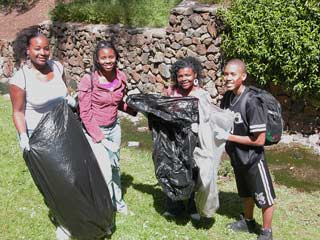UC Berkeley Web Feature
Dirty work for a clean creek
BERKELEY – For several hours at midday on Tuesday, a small army of UC Berkeley students talked (and stalked) trash — as, together with other campus volunteers, they scoured the banks and bed of Strawberry Creek for other people's garbage.
 Classmates Dana Brown, Obiamaka Ude, Aviana Thomas, and Chris Lange collect litter at a spring cleaning of Strawberry Creek. (Cathy Cockrell photo) |
"At the end of the day, this stuff ends up in the
bay," explained
freshman Dana Brown, a participant in the semi-annual
Strawberry Creek cleanup. "I never realized how much stuff there is," she
mused, bending to tease a food wrapper from the undergrowth.
Her cell phone rang. Brown set down her plastic trash
bag to take the call — from
classmates in a course called Environmental Earth
Sciences (a.k.a. EPS 80) — and
was joined shortly in her quest for rubbish by Aviana
Thomas, Obiamaka Ude, and Christopher Lange.
Together
the four worked their way downstream — stopping
under a stone bridge, while they were at it, to do
a "creek observation." As
part of professor Bill Berry's class, Brown
explained, each student selects a section of Strawberry
Creek to monitor weekly throughout the semester,
and must also visit the creek's mouth, near the Berkeley
Marina, to observe what "stuff" finds its
way downstream to the San Francisco Bay.
The
cleanup — held once in the fall (before first
rains have a chance to transport discarded trash
down to the bay) and once in the spring — typically
attracts 25 to 50 volunteers. This time the event
saw a "phenomenal" turnout
of nearly 100 (many of them EPS 80 students lured
by the promise of extra credit), says Tim Pine. An
environmental protection specialist in the campus's
Environment, Health and Safety (EH&S) unit,
Pine was stationed at a table near Sather Gate to
hand out gloves, trash bags, and preparatory advice
to cleanup volunteers. The day was not only bright
but breezy, so "all
the flyers on Sproul Plaza, in about an hour, will
end up in the creek," he
warned. "Don't feel you have to get into the
creek to help."
Creek cleanups are one important element of EH&S's
Strawberry Creek restoration program, along with
reintroducing native fish and insects, removing invasive
exotic plants from the banks, and replacing them
with native flora, says Pine. He notes that
volunteers typically bag about 1,000 pounds of trash
per cleanup. Food wrappers, beverage cups, leaflets and
newspapers account for much of the haul; more exotic
finds from past events include a bicycle wheel, a
shopping cart, a computer chair, and "a
nice copper tea pot" that he displays on his
desk as a trophy.
But
public-education
outreach efforts over the past few years may be working, Pine believes.
The current crop of students, for one, seems "to be taking better
care to not let their garbage hit the ground," he
ventures — with a caveat that "there's no scientific rigor
involved in making that statement. Perhaps I'm just an optimist
and I see the creek as being half full instead of
half empty."
Strawberry Creek now has its own website, offering information on natural history and management, as well as a link to the Strawberry Creek Fund, where one can make donations to support creek stewardship.

